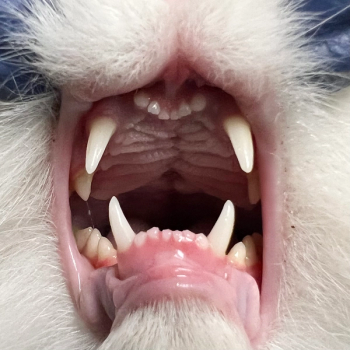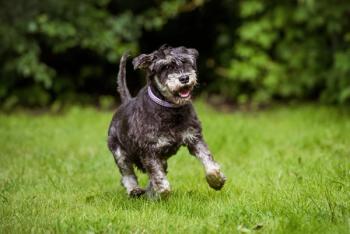
Hip luxation (Proceedings)
Coxofemoral luxation is the most commonly luxated joint in dogs, accounting for 90% of all luxations. It is usually the result of trauma or severe hip dysplasia with 78% being craniodorsally luxated.
Coxofemoral luxation is the most commonly luxated joint in dogs, accounting for 90% of all luxations. It is usually the result of trauma or severe hip dysplasia with 78% being craniodorsally luxated. The primary stabilizers of the hip joint are the joint capsule and the ligament of the head of the femur also known as the round ligament tor the teres ligament. The secondary stabilizers are the periarticular muscles, such as the gluteals and the hydrostatic pressure. In immature dogs, capital physeal fracture may result from hip trauma and dogs less than 11 months are twice as likely to fracture as they are to luxate their hips.
Diagnosis of hip luxation can be made with a history of trauma, physical examination, radiographs, but should also be focused on identifying other traumatic injuries. Physical examination of an acute luxation may show non-weight bearing lameness with external rotation of the femur and adduction of the limb. More chronic luxations may show some weight bearing. Palpation may reveal swelling in the hip region.
Coxofemoral luxation may be identified palpably by placing a thumb in the ischiatic notch (between the greater trochanter and the ischiatic tuberosity) and externally rotating the femur. If the femoral head is normally seated within the acetabulum, the thumb will be displaced from the ischiatic notch with external rotation of the femur. However, if the femoral head is luxated, the clinician's thumb is not displaced when the femur is rotated. The integrity of the coxofemoral joint may also be evaluated by palpation of the craniodorsal border of the ilium, the greater trochanter, and the ischiatic tuberosity.
When the hip is reduced, the greater trochanter is positioned distal to the axis of a line drawn between the craniodorsal border of the ilium and the ischiatic tuberosity, and it is positioned markedly closer to the ischiatic tuberosity than the craniodorsal border of the ilium. With a craniodorsal luxation, the greater trochanter is equidistant from both points. With ventral and caudoventral luxations, the greater trochanter is displaced medially, and hip adduction and internal rotation may be constrained by entrapment of the femoral head within the obturator foramen.
Reduction and stabilization of the coxofemoral joint is preferred in most cases and may be accomplished using closed or open techniques. Conservative treatment can be tolerated in some cats in which, without reduction, a pseudoarthrosis may develop between the luxated femoral head and the caudal portion of the ilium, allowing limited, pain-free function. However, reduction and stabilization of the joint is recommended in cats that fail to bear weight on the limb within 4 to 5 days of injury, and in all dogs with coxofemoral luxation. In most cases, closed reduction of the coxofemoral luxation is attempted first.
Although closed reduction is unsuccessful in many cases, attempted closed reduction before open surgical reduction does not appear to alter the long-term prognosis. However, initial open (surgical) reduction is indicated if acetabular or femoral head fractures are present, the joint reluxates after radiographically confirmed closed reduction, concurrent injuries require immediate return of hip function, or the luxation is chronic and visual evaluation of the cartilage is necessary. After closed reduction of a craniodorsal hip luxation, a non–weight bearing sling (Ehmer sling or figure of eight bandage) is typically applied to the hindlimb to maintain reduction.
The Ehmer sling flexes the hip joint and abducts and internally rotates the femur to position the femoral head within the acetabulum. After closed reduction of a ventral luxation, hobbles may be placed on the hindlimbs (at the hocks or stifles) to prevent limb abduction and maintain joint reduction. However, many ventral luxations are managed successfully without hobbles. In a report of 14 dogs with caudoventral hip luxation, 80% returned to normal gait and function after closed reduction alone.
Insertion of an ischioilial pin (DeVita pin) has been described to stabilize the hip joint after closed reduction. A Steinmann pin is placed through a stab incision ventral to the ischium, is passed cranially over the femoral head, and is embedded into the wing of the ilium. Typically, the pin is allowed to remain in place for 2 to 4 weeks, with exercise restricted for an additional 2 to 4 weeks following removal. A study of 21 dogs with craniodorsal coxofemoral luxation demonstrated that reduction was maintained in 73% of dogs treated with ischioilial pinning; however, the complication rate was 32%.
Complications reported with ischioilial pinning include pin migration, reluxation, sciatic nerve injury, damage to the femoral head, and joint sepsis. External fixation (both rigid and flexible) has been described for maintaining joint stability after closed reduction. No published studies have described the long-term outcome associated with the use of external fixation for hip joint stabilization.
Open reduction of coxofemoral luxations allows exploration of the joint, removal of hematoma and soft tissues entrapped within the acetabulum, and application of internal stabilization. The success rate after open reduction and stabilization (»85%) is significantly greater than after closed reduction. Various techniques are used alone or in combination to stabilize the joint while the joint capsule and periarticular soft tissues heal.
Techniques described for open reduction and stabilization are numerous and include capsulorrhaphy, ischioilial pinning, prosthetic capsule technique, transposition of the greater trochanter, transarticular pinning, toggle rod stabilization, fascia lata loop stabilization, extra-articular iliofemoral suture placement, transposition of the sacrotuberous ligament, femoral head and neck excision arthroplasty, triple pelvic osteotomy, and total hip arthroplasty. Success rates of 83% to 90% have been reported with use of the capsulorrhaphy technique. However, in many cases, the joint capsule is too severely damaged to permit adequate closure.
The prosthetic capsule technique is performed if the joint capsule is damaged or avulsed from the acetabulum, two bone screws or bone anchors are placed in the dorsal acetabular rim to serve as anchor points for suture attachment. The prosthetic capsule technique is reported to prevent reluxation in 66% to 100% of cases. Excellent or good outcomes were noted in 65% to 67% of dogs; 18% had mild lameness and 18% had severe lameness.
Osteotomy of the greater trochanter can improve exposure to the joint for other open reduction techniques. The greater trochanter is reattached with a tension band wire fixation or a lag screw. Trochanteric transposition alone prevented reluxation in 84% of patients in one report. Toggle rod stabilization allows early use of the limb after surgery, which may be necessary if injury to the opposite hindlimb or forelimbs are present.
Although toggle rod fixation is often used as a single technique, this method of repair may be augmented by capsulorrhaphy if a midsubstance tear of the capsule occurs, or by the prosthetic capsule technique if the capsule is avulsed from the acetabular rim or femoral neck. If a dorsal open approach was used, the greater trochanter is transposed or reattached to its original position using tension band wire fixation. Toggle rod relaxation rate is less than 11%, with 81% of dogs exhibiting little or no long-term lameness, when commercial toggles are used.
An extra-articular iliofemoral suturing technique has been described for stabilization of hip luxation in dogs and cats. A hole is drilled from lateral to medial in the ilium just cranial to the acetabulum. A second hole is drilled from caudal to cranial through the femur just distal to the insertion of the gluteal muscles at the base of the greater trochanter. The suture is then passed from cranial to caudal through the hole in the femur, and from caudal to cranial beneath the insertion of the gluteal muscles on the greater trochanter and tied.
An alternative method of placing the suture, which avoids the need to drill holes in the ilium and femur, has been described, in which the suture is anchored cranially in the tendon of origin of the psoas minor muscle and caudally to the tendon of insertion of the middle gluteal muscle. A report of 14 dogs described no reluxations and nor complications with dogs bearing weight 1 to 10 days postoperatively. Lameness persisted for an average of 20 days.
Surgical removal of the femoral head and neck is indicated for the treatment of recurrent hip luxation, concurrent severe fractures of the acetabulum or femoral head and neck, and coxofemoral osteoarthritis. Femoral head and neck excision should be considered if closed and open techniques are unsuccessful, if severe femoral head damage is present and total hip replacement is not an option for the patient or client, or if the client wishes to avoid the possibility of reluxation and additional surgery. Excision arthroplasty is also used by some surgeons as a primary treatment for hip luxation in cats because the procedure typically leads to full return of function.
Triple pelvic osteotomy has been described for management of craniodorsal coxofemoral luxation; it provides stability by rotating the acetabulum laterally to provide greater coverage of the femoral head. This technique has been used primarily for recurrent luxations, for dogs with hip dysplasia, and for coxofemoral luxation after total hip replacement. Hip replacement arthroplasty may be used in cases of chronic reluxation, severe osteoarthritis, or damage to the femoral head.
Postoperative care for most patients with coxofemoral luxation should include confinement and restricted activity for 4 to 6 weeks to allow soft tissue healing. After closed reduction of a coxofemoral luxation, the limb is typically placed in a non–weight-bearing sling (Ehmer or figure of eight) for 7 to 14 days, and the patient is monitored closely for complications. However, many internal stabilization techniques can be used without external coaptation, allowing early postoperative use of the surgically treated limb if necessary. Patients should be monitored closely for clinical signs of reluxation, including lameness, hip pain, and reduced function. Serial radiographic evaluation of the joint is warranted to confirm reduction, monitor for implant complications, and assess the development of osteoarthritis.
Medical management to preserve healthy articular cartilage should be instituted because development of arthritis is a common complication after hip luxation. Initiating OA management should be early to achieve the most benefit. Nutraceuticals, anti-inflammatory drugs and physical rehabilitation should be considered to promote an early return to function and maintenance of joint health when an arthroplasty is not performed. Hip arthroplasty, either hip replacement or femoral head ostectomy, require specific postoperative care and exercise regimes.
The prognosis after coxofemoral luxation is fair to good if reduction and stability are achieved soon after injury. A long-term study (8 to 156 months' follow-up) of 64 dogs treated for coxofemoral luxation using various techniques, including closed reduction and bandaging, extracapsular suture stabilization, toggle rod stabilization, DeVita pinning, and femoral head and neck excision arthroplasty, found that 62% showed no lameness and 20% were severely lame.
Palpation of the hip joint revealed crepitus in 32% of dogs and pain in 48% of dogs. In all, 92% of dogs were found to have normal range of motion in the affected hip joint. Investigators also reported that the presence of concomitant injuries and treatment delayed for longer than 3 days did not result in a worse prognosis. Osteoarthritis of the hip joint progresses in 55% to 62% of patients after coxofemoral luxation and was more pronounced in heavier dogs.
Newsletter
From exam room tips to practice management insights, get trusted veterinary news delivered straight to your inbox—subscribe to dvm360.






